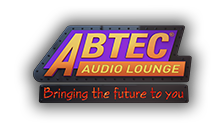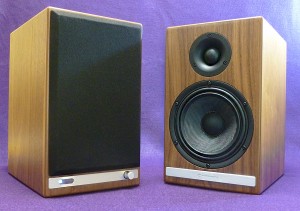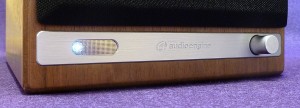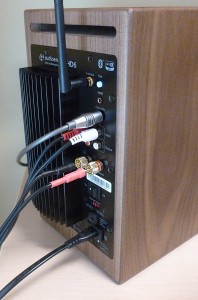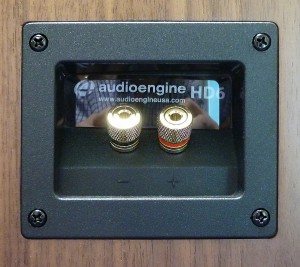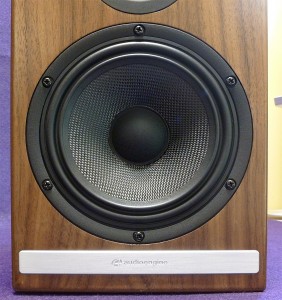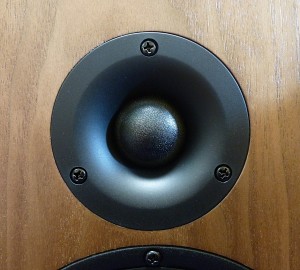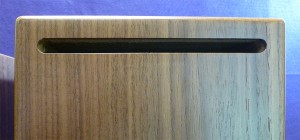It’s no secret that I’m a fan of Audioengine. Their products—from the small A2+ to the larger A5+ speakers— are solidly built, affordable without being cheap, and sound terrific. What’s not to like? When I reviewed the A5+ speakers, I talked about how massive they were in both weight and sound. I used to think they were great speakers—I still do, but now not as much. The venerable A5+ speakers have been upstaged in a major way by Audioengine’s new HD6 powered speakers.
Audioengine has taken two steps forward and one step back with the new HD6. That step back is a good thing—let me explain. While Audioengine makes great speakers, the design has always been more functional than pretty. I’ve always liked their appearance, but I can see where some may find the speakers a bit too utilitarian looking—because they are. The A2+ and especially the larger A5+ speaker’s design simply will not fit into the decor of some living rooms. Audioengine took a step back and gave the HD6 a classic appearance, similar to the look of speakers from the 70s or 80s.
The HD6 speakers come in three finishes: Satin black (paint), cherry wood veneer or walnut wood veneer. I have the walnut, because it looks the best to my eyes—it’s strictly a matter of preference. For the first time, Audioengine has provided front grills for a speaker. This may help convince that skeptical spouse or partner that a new set of speakers can now blend with the furnishings without shouting, “Look at me, I’m a speaker!” The HD6 speakers have a subtle beauty—so unlike the A5+. The grill’s use magnetic attachments, so if you prefer a more traditional no grill look, they can be easily removed and stored away.
At the bottom of both the left and right speaker is a tasteful Audioengine logo etched into an aluminum accent bar. The left speaker has a volume/sleep knob and a power light that slowly fades in and out when the speakers are in sleep mode.
However, don’t let their looks fool you. All you have to do is turn the left speaker around to see that the HD6 speakers are actually monsters dressed to kill. There’s some cool features included. The most obvious is that the HD6 speakers are self-powered, which simply means that they don’t require a separate amp to drive them, because it’s built-in. And it ain’t no wimpy amp, either.
It’s 150 watts (75w per left/right channel) of “Let’s damage our hearing” power, which can generate quite a bit of heat. To solve this, Audioengine included a large heat-sink to help keep the speaker’s amp cool. Note that the A5+ speakers have the same power rating—150 watts, but for reasons I can’t figure out; the HD6 sounds more powerful.
I asked Audioengine why and they said that it’s because that the “HD6 uses larger—and more efficient—drivers. The new cabinet design of the HD6 is optimized to take advantage of these new tweeters and woofers so the HD6 is using the available power in a slightly different way.” Well, whatever they did; it works. Listening to music turned up loud is just plain fun.
Compared to the A5+ speakers, the HD6 drivers are larger, but not that much larger. It’s 5 in. vs 5.5 in. woofers and 3/4 in. vs 1 in. silk dome tweeters. There’s also a thin bass port slot at the rear of both speaker cabinets which allows the woofer to have the air it needs to move more freely.
Also at the rear of the left speaker are: an AUX port, RCA audio input and output ports, speaker connectors (for the right speaker), power switch and an optical audio input (TOSLINK). This optical input is cool, because if your device (computer, TV, DVD player, etc.) has an optical out port, then the music/audio can have a more direct digital path right to the HD6 speaker.
The headphone port on newer iMacs (like mine) also doubles as an optical out port—not many people know this. I purchased an optical (mini plug to TOSLINK plug) cord and the results are way better than using the iMac port as a standard headphone port. The reason for this is that the HD6 speakers have a built-in digital audio converter (DAC) bypassing the cheaper, inferior DAC of my iMac. Audio is cleaner and has more presence using this method. Note: The benefit of using the HD6’s DAC depends on the quality of the source DAC.
There’s another cool factor I haven’t mentioned yet—Bluetooth. The HD6 speakers utilize the same Bluetooth technology Audioengine uses on their B1 Bluetooth Music Receiver. Once the HD6 is paired with any smartphone, that smartphone will become a powerhouse music player. Bluetooth 4.0 is used, plus aptX Bluetooth for non-Apple smartphones.
While waiting for my optical cord to arrive, I used the Bluetooth option from my iMac. Granted, Bluetooth sounds better now than it ever has, but hands down, hardwiring (especially via optical) is the way to go. Unless you need to use Bluetooth for convenience, I strongly suggest hardwiring. It’s will always be better.
Setting up the HD6 speakers was quick and painless, with easy Bluetooth pairing. I’ve seldom have issues with Audioengine’s tech, and the HD6 is no exception. Audioengine recommends 50-60 hours of break-in time to let the HD6 speakers reach their peak performance, but seriously, they will sound great the first time they’re turned on.
The HD6 speakers come with all the accessories necessary to get started—except an optical cable, which is not that expensive to purchase. As with all of their previous speakers, each HD6 speaker is packed in a nice drawstring bag. Speaking of accessories, Audioengine has also provided a remote. You may be thinking, “Big deal—other wireless speakers have remotes.” Not like this one, they don’t.
While most remotes feel like an afterthought, this one is made from a block of machined aluminum and is a solid as a brick. Why can’t everyone do this? The remote’s functions are basic with just four buttons—Sleep Mode, Volume up/down and Mute. There is no Play/Pause/Skip function.
As cool looking and well-built as the HD6 speakers are, it’s the sound that matters and it’s the sound that delivers. I really like Audioengine’s A5+ speakers. They’re affordable (for quality speakers), powerful and pack a punch that’s hard to resist. Audioengine has promoted all that goodness of the A5+ to another level. As I said before, while the A5+ has the same power rating as the HD6, the HD6 uses its power more efficiently, resulting in a bass that kicks harder and deeper, while still letting the higher frequencies sparkle even brighter. Audioengine makes a subwoofer that will work seamlessly with the HD6 speakers—but seriously, the bass is already tight and low enough to make me question if a sub is even necessary. It’s that good out of the box.
Listening to various genres of music bear that out. Steely Dan are one of the best audiophile rock choices because in the studio, they were meticulous to a fault. Their albums sparkle with a clarity and punch few artists have accomplished. Where many rock artists’ studio work is sloppy, Steely Dan is a group whose music benefits from higher resolution recordings. “Bodhisattva” begins with a drum kick that is sharp and succinct.
The instrumentals in this song are clearly delineated, yet mesh perfectly. The bass guitar is earthy sounding, yet the individual strings being plucked stand out. The HD6 speakers are able to exhibit this with effortless ease, especially when played LOUD. The same is true in the song, “Rikki Don’t Lose That Number,” where the bass is center stage.
When Bill Graham’s introduction of Janis Joplin with Big Brother and the Holding Company was announced at the beginning of their “Cheap Thrills” album recorded live in 1968 at the Winterland Ballroom in San Francisco, you can sense the electricity of an event in the making. And what an event it turned out to be. “Combination of the Two” and the hit “Piece of My Heart” weren’t superbly recorded, but the HD6 speakers capture all the grit, grime and glory of that seminal recording. Another one to play loud.
Then there’s “Silent Shout” by The Knife—my new go-to bass tester song (thanks to a recent review I read about different speaker). If a speaker can survive this bottom-end onslaught, they have to be pretty good. The HD6 speakers survived it and then some. They reproduced the bass without any distortion, plus were able to exhibit the lead singer’s throaty growl as well while higher frequency synth notes played over it. This was a test where the HD6 excelled.
Once again, Audioengine has made a pair of speakers that should thrill the buyer and continually amaze with killer audio. Maxell (an audio tape manufacturer) did an ad in the 80s to show off their ability to record everything accurately. That ad showed a guy in a chair sitting in front of a pair of speakers that were literally blowing his hair and scarf back by the sheer power of the audio. That’s how it feels sitting in front of Audioengine’s HD6 powered speakers.
Product Information
Price: $1489.00 NZD
Manufacturer: Audioengine
Pros:
Fantastic sound
Needs no subwoofer
Well built
Bluetooth
Built-in amp and DAC
Optical input
Efficient use of power
Cons:
Expensive (but worth it)
Read more at: http://the-gadgeteer.com
Where to buy Audioengine: http://abtec.co.nz/
